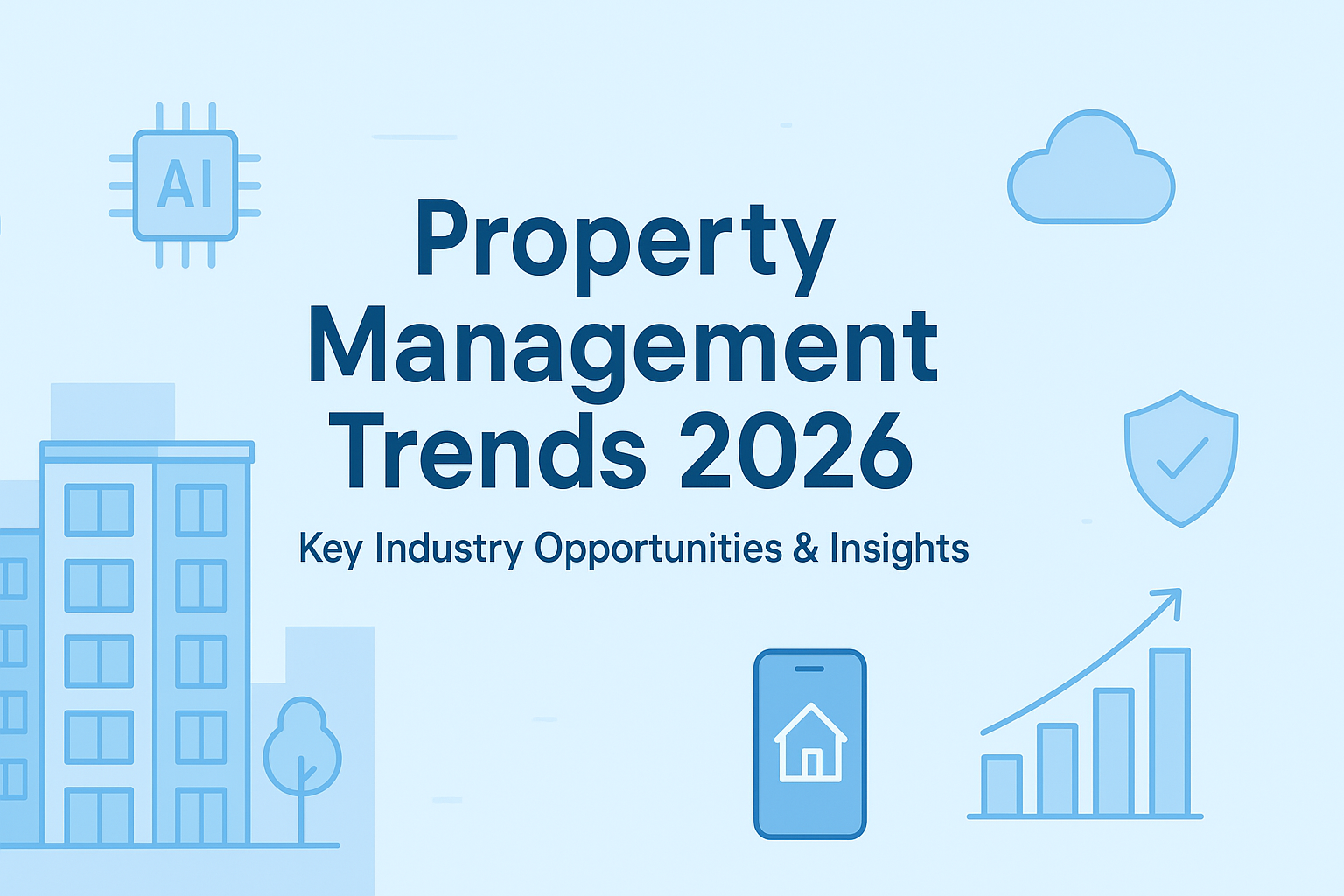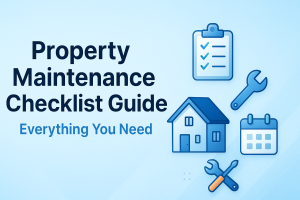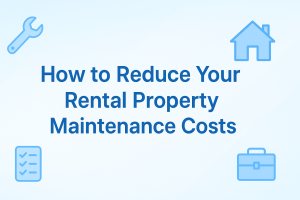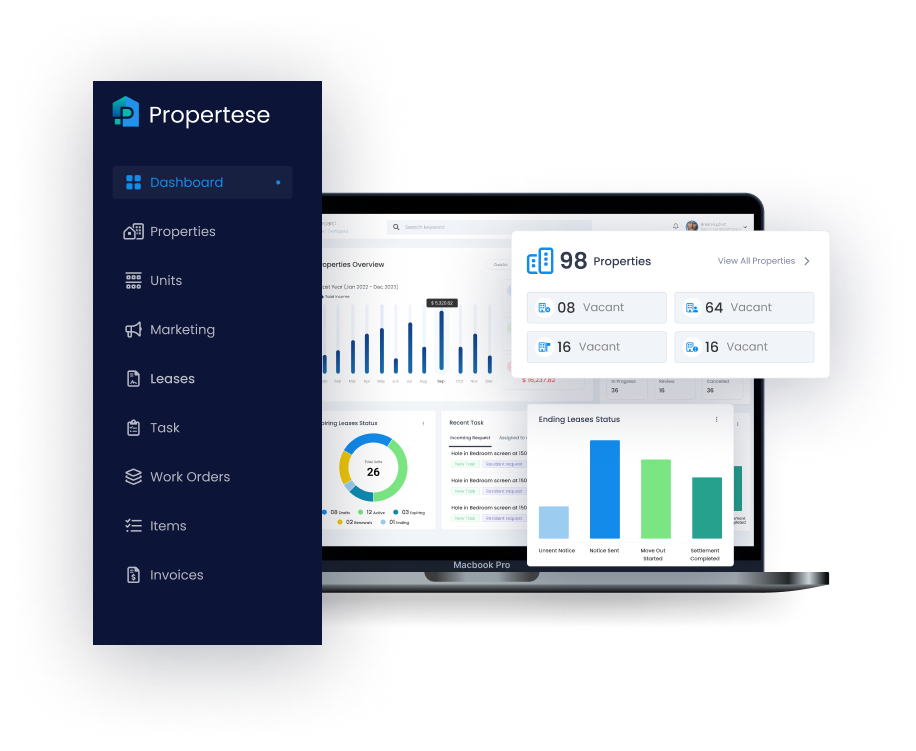
The U.S. property management market hit $84.73 billion in 2025 and is projected to reach $102.79 billion by 2030, that’s a 3.94% annual growth rate. But here’s what really matters: the way we manage properties is fundamentally changing, driven by technology, shifting tenant expectations, and new economic realities.
What’s driving the property management trends reshaping our industry:
- AI and automation are moving from “nice to have” to competitive necessity
- Cybersecurity threats are costing property managers millions in breaches
- Tenant expectations around digital experiences have permanently shifted
- Operating costs are climbing while rent growth is moderating
This isn’t just another trends article. We’ve analyzed data from the U.S. Bureau of Labor Statistics, leading consulting firms, and CoStar’s multifamily market reports to identify what will actually impact your bottom line in 2026.
Let’s dive into the property management trends that matter and what you need to do about them.
AI Integration: From Experiment to Essential Operating Tool
AI adoption is transitioning from experimentation to operational deployment in real estate. According to PwC/ULI’s Emerging Trends in Real Estate 2026, artificial intelligence is “no longer just an experimental tool, it is gradually becoming a practical driver of efficiency and performance.”
McKinsey’s research projects that generative AI could contribute between $110-180 billion in value to the real estate sector by 2032. That’s not, that’s a fundamental shift in how property operations work.
Where AI Actually Delivers ROI in Property Management
Based on industry analysis from consulting firms, three areas show the clearest potential for return on investment:
- Predictive Maintenance: Instead of responding to tenant complaints about broken HVAC systems, AI analyzes patterns to predict failures before they happen. Property managers implementing predictive maintenance programs are seeing measurable reductions in emergency repair costs.
The approach is compelling: equipment that receives predictive maintenance has significantly fewer failures than reactively maintained assets. Learn more about how property managers can use maintenance teams to increase ROI.
- Dynamic Pricing Optimization: Markets change daily. AI-driven pricing tools analyze local supply, demand signals, competitor rates, and seasonal patterns to optimize rent pricing in real-time.
- Tenant Screening and Leasing: AI processes rental applications faster and more consistently than manual review. What used to take 3-5 days now happens in hours, reducing vacancy costs and improving the applicant experience.
The Employment Impact Nobody’s Talking About
AI has reduced entry-level employment by 13% in AI-exposed occupations across industries. Property management isn’t immune.
But the solution isn’t to avoid AI, it’s to deploy it strategically. The most successful property management companies are using AI to augment staff capabilities, not replace them entirely.
The median wage for property managers hit $66,700 in May 2024, with employment projected to grow 4% from 2024-2034 according to the U.S. Bureau of Labor Statistics. The jobs aren’t disappearing, they’re evolving.
Cybersecurity: The $9.36 Million Risk You Can’t Ignore
Let’s talk about a property management trend that keeps executives up at night: cybersecurity breaches.
The numbers are staggering. According to the IBM/Ponemon Cost of a Data Breach Report 2024, the average cost of a data breach in the U.S. reached $9.36 million in 2024. For context, that’s the annual revenue of a 150-unit property management portfolio.
58% of organizations experienced a data breach or cybersecurity incident in the past two years. This isn’t a “might happen” scenario; it’s a “when will it happen” reality.
Why Property Management is a Prime Target
Property managers are goldmines for cybercriminals because you hold:
- Tenant personal information (SSNs, bank accounts, employment data)
- Owner financial data and tax information
- Payment processing systems with direct bank access
- Vendor credentials and access codes
- Building security system access
The December 2023 REWN data breach exposed over 1.5 billion records, including sensitive property owner and real estate ownership information. That’s the scale of risk we’re dealing with.
The Real Cost Beyond the Headline Number
A $9.36 million breach isn’t just about the immediate remediation costs. Consider:
- Notification costs: Breach notifications average $590,000
- Lost business: Tenants and property owners leave after breaches
- Regulatory fines: State privacy laws and industry regulations carry penalties
- Reputation damage: Your brand can take years to recover
- Insurance premium increases: Cyber insurance rates spike post-breach
What Property Managers Must Do Now
According to the Ponemon Institute report, the average cybersecurity budget reached $24 million in 2025 (scaled to company size). For property managers, the priorities are clear:
Priority 1: Internal Security Assessment (63% of companies prioritize this). Conduct a comprehensive security audit of your systems, processes, and vendor access. You can’t fix what you don’t know is broken.
Priority 2: Multi-Factor Authentication (MFA) Everywhere. Every system that touches tenant or owner data needs MFA. Period. This single step blocks the majority of credential-based attacks.
Priority 3: Vendor Security Requirements. Your vendors have access to your systems and data. Require security certifications, conduct vendor audits, and include security SLAs in contracts.
Priority 4: Incident Response Planning. When (not if) you detect suspicious activity, having a tested incident response plan means the difference between a contained incident and a catastrophic breach.
Priority 5: Staff Training. According to research cited in the Ponemon report, phishing affects 85% of breached businesses. Your staff is either your strongest defense or your weakest link.
Learn more about property management best practices that include security considerations.
Market Dynamics: Vacancy Normalization and Rent Growth Reality Check
If you’re building 2026 business plans on aggressive rent growth projections, we need to talk.
The Vacancy Picture
The U.S. rental vacancy rate stood at 6.8% in 2024, according to U.S. Census Bureau data tracked by the Federal Reserve Economic Data (FRED). For multifamily specifically, the national vacancy rate is at 8.2% in Q4 2025, projected to ease only slightly to 7.9% by the end of 2026.
This isn’t temporary. Vacancy rates have normalized after years of pandemic-era tightness, and the market is rebalancing.
Rent Growth Is Moderating – Fast
National apartment asking-rent growth was just 0.9% year-over-year in Q2 2025, according to CoStar’s Apartments.com Rent Growth Report. That’s down from 1.5% at the start of 2025 and nowhere near the double-digit growth we saw in 2021-2022.
Single-family rental markets tell the same story. CoreLogic reports single-family rent growth slowed to approximately 1.5% year-over-year in late 2024, a significant cooldown from prior years.
Regional Dispersion Matters More Than Ever
National averages hide massive regional variations.
Markets with the strongest rent growth:
- San Francisco: 6.1% annual growth
- San Jose: 3.8%
- Chicago: 3.8%
Markets with the weakest performance:
- Austin: -4.4% (declining rents)
- Denver: -3.8%
- Phoenix: -2.9%
The National property management trends mean nothing if you’re operating in an oversupplied market.
What This Means for Your 2026 Strategy
1. Occupancy Over Rent Pushes: When vacancy is elevated, pushing rents aggressively backfires. A 3% rent increase that causes 5% additional turnover destroys value. Focus on retention and occupancy.
2. Market-Specific Underwriting: Stop using national rent growth assumptions in your proformas. Use local market data from CoStar, local multifamily associations, or market-specific analytics.
3. Value-Add Through Operations: When you can’t rely on rent growth to drive NOI increases, operational improvements become essential. This is where technology, better vendor management, and efficiency gains create value.
Discover how to track vacancy and occupancy rates more effectively with modern property management tools.
Tenant Experience: Digital Expectations Are Non-Negotiable
One of the most impactful property management trends for 2026 is the permanent shift in tenant expectations around digital experiences.
What Tenants Actually Want
1. Digital Leasing and Self-Service: Tenants expect to view properties virtually, submit applications online, sign leases electronically, and move in without unnecessary in-person touchpoints.
2. Instant Communication Channels: Text messaging, mobile apps, and chatbots for routine questions aren’t perks; they’re baseline expectations. Response time matters more than channel preference.
3. Transparent Pricing and Fees: Hidden fees and surprise charges drive negative reviews and non-renewals. Clear, upfront pricing builds trust and improves retention.
4. Online Payment Options with Flexibility: Tenants want to pay rent how and when it works for them: mobile app, auto-pay, credit card, ACH. Properties accepting credit card rent payments see higher on-time payment rates.
5. Amenity Value Over Amenity Volume: It’s not about having the most amenities—it’s about having amenities tenants actually use and value. Underutilized amenities are cost centers, not value drivers.
The ROI of Digital Tenant Experience
Property managers who’ve implemented comprehensive tenant portals report measurable improvements in operational efficiency and tenant satisfaction.
The Risk of Falling Behind
Here’s what many property managers miss: your tenants compare you to their entire digital experience, Amazon, Netflix, and their banking app. If your leasing process requires PDFs, physical signatures, and mailed checks, you’re competing with one hand tied behind your back.
Learn how to create a paperless leasing process that tenants actually prefer.
Operating Cost Pressure: The Squeeze on Profit Margins
While rent growth moderates, operating costs keep climbing, and that’s creating a real margin squeeze in 2026.
The Cost Increases You’re Facing
Labor isn’t getting cheaper. The median annual wage for property managers has climbed steadily, and that’s just property managers—maintenance staff, leasing agents, and admin roles are all facing wage pressure in tight labor markets.
Then there’s insurance. According to the Harvard Joint Center for Housing Studies, insurance premiums and property taxes have surged, creating serious financial stress for landlords. Meanwhile, municipalities facing their own budget pressures keep raising property tax rates—often faster than your rental income is growing.
Why Automation Isn’t Optional Anymore
Here’s the thing: if you can’t grow revenue aggressively and you can’t control some costs, you’ve got one option left, improve operational efficiency through technology.
It’s not about replacing people. It’s about giving your team the tools to do more with less friction.
Explore property management tasks you should automate today to protect your margins.
Single-Family Rental Market: Record Investor Activity
Single-family rental is having a moment in 2026, and it’s worth paying attention to.
Nearly a third of single-family home purchases in the first half of 2025 were made by investors. That’s a record high, driven mostly by individual buyers who’ve been priced out of homeownership.
Now, you’ve probably seen those scary headlines about Wall Street buying up every single-family home in America. However, institutional investors own only a small slice of the single-family rental market. Regular people, mom-and-pop landlords managing a few properties, still own the overwhelming majority of single-family rentals.
The performance story isn’t exciting either. Single-family rent growth has cooled off considerably, and vacancy is at levels we haven’t seen since the mid-2010s.
Stop trying to squeeze every last dollar out of rent increases. In 2026, your money is made by keeping units occupied and turning them quickly when tenants move out. A unit sitting vacant for an extra two weeks costs you more than a modest rent bump would gain you.
The gap between what institutional operators can do and what small landlords are doing keeps getting wider. And it’s not about money, it’s about systems. When a small operator adopts property management software, they suddenly have the same capabilities the big guys do. Automated maintenance tracking. Real financial reporting. Tenant portals that work. All the stuff that used to require a full office staff.
If you’re growing your single-family portfolio by partnering with property owners, check out how to manage third-party properties efficiently.
Sustainability and Climate Risk: This Is About Money Now
Let’s be clear: sustainability isn’t just a feel-good initiative anymore. Climate risk is now central to investment decisions, and it’s hitting your wallet through insurance costs, property valuations, and regulatory compliance.
Here’s where you can actually move the needle without massive investment:
- LED lighting retrofits pay for themselves quickly. Plus, LEDs last forever, which means fewer maintenance calls.
- Smart thermostats aren’t just about energy savings—they enable predictive maintenance on your HVAC equipment, catching problems before they become expensive emergencies.
- Water efficiency upgrades like low-flow fixtures, smart irrigation, and leak sensors reduce what’s often your second-largest utility expense.
Regulatory Complexity and Portfolio Diversification
Property managers are dealing with a flood of new regulations right now. Rent control. Tenant protection laws. Fair housing requirements. Data privacy rules. It feels like every month there’s something new to comply with.
Stay on top of it by joining property management associations that actually track these changes for you. Get your compliance tracking centralized in one system instead of scattered across spreadsheets and sticky notes. And if you operate in multiple states, you need to know the specific requirements for each one because they vary wildly.
Remember a few years back when rent growth was double-digit and you could basically throw money at any hot market and come out ahead? Those days are over. Now that growth has moderated and different regions are performing completely differently, having everything concentrated in one market or property type is risky.
Think about spreading your risk. Affordable housing stays stable even in downturns. Student housing gives you predictable occupancy tied to academic calendars.
Technology Stack Consolidation: Stop the Frankenstein Approach
Here’s a scenario you might recognize: over the years, you’ve added one system for accounting, another for maintenance work orders, a third for tenant portals, a fourth for leasing, a fifth for owner reporting…
You’ve built a Frankenstein tech stack. And it’s costing you more than you think.
The problems with this approach:
You’ve got data trapped in individual systems that don’t talk to each other. Your team is re-entering the same information across multiple platforms (hello, human error). APIs break, syncs fail, and suddenly your rent roll doesn’t match your accounting system. You’re paying for multiple subscriptions, multiple training sessions, and multiple support contracts. And every new system is another potential security vulnerability.
There’s a better way:
Leading property managers are consolidating onto platforms that handle everything in one place: property and unit management, leasing and applications, maintenance and work orders, rent collection, and financial reporting.
The Metrics That Actually Matter in 2026
You can’t improve what you don’t measure. Focus on these property management KPIs:
Financial metrics:
- Occupancy rate (keep it high)
- Rent growth (be realistic about your market)
- Same-store NOI growth
- Maintenance cost per unit
Operational metrics:
- Average days to lease a unit
- How fast you’re completing work orders
- What your tenants actually think (satisfaction scores)
- Staff productivity
Technology adoption:
- How many tenants are actually using your portal
- Percentage of rent collected online
- Time saved through automation (measure this before and after)
Platforms like Propertese give you real-time reporting on all of this, so you’re not digging through spreadsheets at month-end.
Conclusion
The property management trends shaping 2026 aren’t subtle. Technology has moved from “nice to have” to “competitive necessity.” Tenant expectations aren’t going backward. Margins are getting squeezed. Cybersecurity threats are real and expensive. Regulations keep getting more complex.
The property managers who’ll thrive in 2026 are the ones who:
- Embrace technology strategically and actually measure ROI (not just buy shiny tools)
- Treat cybersecurity as an operational priority, not an IT checkbox
- Obsess over tenant experience because retention beats acquisition every time
- Build operational resilience through real efficiency gains, not just cost-cutting
- Make decisions based on data, not gut feel
Here’s the good news: the tools, technology, and best practices you need already exist. The only question is whether you’ll implement them before your competition does.
Table of Contents
Stay Updated
Subscribe to get the latest news, industry trends, blog posts, and updates...




